ご使用の前に、この使用説明書をよくお読みの上、正しくお使いください。また、
カメラの説明書もご覧ください。
•
このレンズは、ニコン
Z マウントのミラーレスカメラ専用です。
安全上のご注意
あなたや他の人々への危害や財産への損害を未然に防止するため、ご使用の前に「安全上の
ご注意」をよくお読みの上、正しくお使いください。
この説明書をお読みになった後は、いつでも参照できるように保管してください。
A
警告
「死亡または重傷を負うおそれがある内容」です。
A
注意
「軽傷を負うことや財産の損害が発生するおそれがある内容」です。
お守りいただく内容を、以下の図記号で区分しています。
F
は、してはいけない内容です。
C
は、実行しなければならない内容です。
A
警告
E
分解
禁止
分解、修理または改造をしない
落下などによる破損で内部が露出したら、露出部に触らない
感電やけがの原因になります。
C
実行
熱くなる、煙が出る、こげ臭いなどの異常時は、直ちにカメラの電源を取り
外す
放置すると、発火、やけどの原因になります。
F
禁止
水でぬらさない
ぬれた手で触らない
感電や発火の原因になります。
F
禁止
引火、爆発のおそれのある場所では使わない
プロパンガス、ガソリン、可燃性スプレーなどの引火性ガスや粉塵の発生す
る場所で使うと、爆発や火災の原因になります。
F
禁止
レンズで直接太陽や強い光を見ない
失明や視力障碍の原因になります。
F
禁止
幼児の手の届くところに置かない
故障やけがの原因になります。
小さな付属品を誤って飲み込むと、身体に悪影響を及ぼします。飲み込んだ
ら、すぐに医師の診断を受けてください。
G
禁止
高温環境や低温環境では、直接触らない
やけどや低温やけど、凍傷の原因になることがあります。
A
注意
F
禁止
レンズを太陽や強い光源に向けたままにしない
集光して、内部部品の破損や発火の原因になることがあります。
逆光撮影では、太陽を画角から十分にずらしてください。
画角から太陽をわずかに外しても、発火の原因になります。
F
禁止
夏場の車内や直射日光の当たる所など高温環境に放置しない
故障や発火の原因になります。
F
禁止
三脚などにカメラやレンズを取り付けたまま移動しない
故障やけがの原因になります。
レンズの使い方
各部の名称と機能
左図で示されている各部の名称と機能は以下の通りです。
●
q
レンズフード着脱指
標
レンズにレンズフードを取り付けるときの指
標です。
詳しくは
B
●
w
コントロールリング
オートフォーカス時
このリングを回転させると、[フォーカス(
M/
A
)]や[絞り]などカメラで設定した機能を
使用できます。詳しくは、カメラの説明書に
記載されている[カスタムボタンの機能]ま
たは[カスタムボタンの機能(撮影)]の説明
をご覧ください。
—
マニュアルフォーカス時
このリングを回転させると手動でピント合わ
せができます。
—
●
e
レンズ着脱指標 カメラにレンズを取り付けるときの指標です。
詳しくは
A
●
r
レンズマウント
ゴムリング
— —
●
t
CPU
信号接点 カメラとレンズの間で情報を伝達します。 —
●
y
フォーカスモード
切り換えスイッチ
[
A
]を選ぶとオートフォーカスになり、[
M
]
を選ぶとマニュアルフォーカスになります。
•
カメラのフォーカスモードがマニュアルフォー
カスのときは、レンズで[
A
]を選んでいても
マニュアルフォーカスになります。
—
●
u
レンズフード
画像に悪影響を及ぼす光線をカットします。
レンズ面の保護にも役立ちます。
詳しくは
B
●
i
レンズフードセット
指標
レンズにレンズフードを取り付けるときの指
標です。
●
o
レンズフード取り付
け指標
●
!0
レンズキャップ
(
フロントキャップ
)
— —
●
!1
レンズキャップ
(リアキャップ)
— —
A
カメラへの取り付け方・取り外し方
取り付け方
z
カメラの電源を
OFF
にして、レンズのリアキャップとカメラのボ
ディーキャップを外す
x
カメラとレンズのレンズ着脱指標を合わせ、反時計回りにカチッ
と音がするまでレンズを回す
取り外し方
z
カメラの電源を
OFF
にする
x
レンズ取り外しボタンを押しながら、時計回りにレンズを回して
取り外す
B
レンズフードの取り付け方・取り外し方
•
レンズフード着脱指標とレンズフード取り付け指標を合わせて(
q
)、レンズフー
ドを矢印(
w
)の方向に回転させ、レンズフード着脱指標とレンズフードセット
指標を合わせてください(
e
)。
レンズフード取り付け指標
レンズフード着脱指標 レンズフードセット指標
•
レンズフード先端を強くつかむと着脱が困難になります。着脱の際は、レンズフー
ド取り付け指標(●)付近を持って回転させてください。
•
取り外しは、取り付けと逆の手順で行ってください。
•
収納時はレンズフードを逆向きにしてレンズに取り付けられます。
内蔵フラッシュ搭載のカメラでフラッシュ撮影
するときのご注意
カメラの内蔵フラッシュを使用すると、フラッシュの光がレンズでさえぎられて、
画像の一部に影ができます。
カメラにレンズを取り付けたときのご注意
ピント合わせを行った後に、カメラの電源を OFF にして再び ON にするとピント位
置が変わることがあります。ピントをあらかじめ合わせておいて被写体を待つ置き
ピン撮影などでは、ピントを合わせてからシャッターをきるまでにカメラの電源を
OFF にしないことをおすすめします。
取り扱い上のご注意
•
レンズフードをレンズに装着した状態で、レンズフードだけを持たないでください。
•
CPU 信号接点は汚さないようにご注意ください。
•
レンズマウントゴムリングが破損した場合は、そのまま使用せず販売店またはニコン
サービス機関に修理を依頼してください。
•
レンズをカメラに装着していないときは、必ずレンズキャップを取り付けてください。
•
レンズを保管するときは、レンズ内部を保護するために太陽光のあたらない所に保管
してください。
•
レンズを水にぬらしたり、湿気の多い場所に置かないでください。部品がサビつくな
どして故障の原因になりますのでご注意ください。
•
火の近くなど、極端に温度が高くなるところに置かないでください。外観の一部に使
用している強化プラスチックが変形することがあります。
•
極端に温度差のある場所に急にレンズを持ち込むと、レンズ内外に水滴が生じ、故障
の原因となります。レンズをバッグやビニール袋などに入れて、周囲の温度になじま
せてからお使いください。
•
レンズを傷から守るために、持ち運ぶときはレンズケースに入れることをおすすめし
ます。
レンズのお手入れ
•
レンズ面を清掃する場合、通常はほこりを払う程度にしてください。
•
レンズ面に指紋など油分を含む汚れがついたときは、少量の無水アルコール(エタノー
ル)や市販のレンズクリーナーで湿らせた柔らかい清潔な木綿の布または市販のレン
ズクリーニングペーパーを使って、レンズの中心から外周へ渦巻き状に拭いてくださ
い。その場合、拭きムラや拭き残りがないように注意してください。
•
シンナーやベンジンなどの有機溶剤は絶対に使用しないでください。
•
レンズ表面の汚れや傷を防ぐには、別売のニュートラルカラー
NC フィルターなどの
使用をおすすめします。
•
レンズを長期間使用しないときは、カビやサビを防ぐために、高温多湿のところを避
けて風通しのよい場所に保管してください。また、直射日光のあたるところ、防虫剤
のあるところも避けてください。
アクセサリー
付属アクセサリー
•
レンズキャップLC-77B(フロントキャップ)
•
レンズキャップ
LF-N1(リアキャップ)
•
レンズフード
HB-95
•
レンズケースCL-C1
D
レンズケースのお取り扱いについて
•
レンズケースはレンズを傷から守ることを目的としており、落下や衝撃からレンズ
を保護する機能はありません。
•
レンズケースに撥水機能はありません。
•
レンズケースは材質の特性上、雨や水などで濡れた場合や摩擦によって、色落ち、
変色、色移り、伸縮することがあります。
•
ほこりは柔らかいブラシで払い落としてください。
•
表面に付着した汚れや水分は、乾いた柔らかい布で拭き取ってください。アルコール、
ベンジン、シンナーなどの溶剤は使わないでください。
•
直射日光があたる場所や、温度、湿度の高い場所に放置しないでください。
•
レンズ面や液晶画面などを拭くクリーニングクロスとしては使用できません。
•
レンズを収納して持ち運ぶ際、レンズが転がり出ないようご注意ください。
レンズケースの素材:ポリエステル
使用できるアクセサリー
77mm ネジ込み式フィルター
D
フィルターを使用する場合
•
フィルターは 1 枚で使用してください。
•
フィルターは、レンズフードを取り外してから装着してください。また、円偏光フィ
ルターの偏光効果の調節も、レンズフードを取り外した状態で行ってください。
仕様
マウント ニコン Z マウント
焦点距離
20mm
最大口径比 1:1.8
レンズ構成
11 群 14枚(ED レンズ 3 枚、非球面レンズ 3 枚、ナノク
リスタルコートあり)
画角
94°(撮像範囲FX)
70°(撮像範囲DX)
フォーカシング方式
IF(インターナルフォーカス)方式
最短撮影距離 撮像面から
0.2m
最大撮影倍率 0.19 倍
絞り羽根枚数
9 枚(円形絞り)
絞りの範囲
f/1.8—16
アタッチメントサイズ 77mm(P=0.75mm)
寸法
約
84.5mm(最大径)×108.5mm(レンズマウント基準
面からレンズ先端まで)
質量 約
505g
製品の外観・仕様・性能は予告なく変更することがありますので、ご了承ください。
Jp
使用説明書
En
User’s Manual
Before using this product, please read these instructions carefully. You will also need to
consult the camera manual.
• This lens is intended exclusively for use with mirrorless cameras featuring a Nikon Z
mount.
For Your Safety
To prevent damage to property or injury to yourself or to others, read “For Your Safety”
in its entirety before using this product.
Keep these safety instructions where all those who use this product will read them.
A WARNING: Failure to observe the precautions marked with this icon could
result in death or severe injury.
A CAUTION: Failure to observe the precautions marked with this icon could
result in injury or property damage.
A WARNING
• Donotdisassembleormodifythisproduct.
Donottouchinternalpartsthatbecomeexposedastheresultofafallor
otheraccident.
Failure to observe these precautions could result in electric shock or other injury.
• Shouldyounoticeanyabnormalitiessuchastheproductproducingsmoke,
heat,orunusualodors,immediatelydisconnectthecamerapowersource.
Continued operation could result in fire, burns or other injury.
• Keepdry.
Donothandlewithwethands.
Failure to observe these precautions could result in fire or electric shock.
• Donotusethisproductinthepresenceofammabledustorgassuchas
propane,gasolineoraerosols.
Failure to observe this precaution could result in explosion or fire.
• Donotdirectlyviewthesunorotherbrightlightsourcethroughthelens.
Failure to observe this precaution could result in visual impairment.
• Keepthisproductoutofreachofchildren.
Failure to observe this precaution could result in injury or product malfunction. In
addition, note that small parts constitute a choking hazard. Should a child swallow
any part of this product, seek immediate medical attention.
• Donothandlewithbarehandsinlocationsexposedtoextremelyhighor
lowtemperatures.
Failure to observe this precaution could result in burns or frostbite.
A CAUTION
• Donotleavethelenspointedatthesunorotherstronglightsources.
Light focused by the lens could cause fire or damage to product’s internal parts.
When shooting backlit subjects, keep the sun well out of the frame.
Sunlight focused into the camera when the sun is close to the frame could cause
fire.
• Do not leave the product where it will be exposed to extremely high
temperatures,foranextendedperiodsuchas inan enclosedautomobile
orindirectsunlight.
Failure to observe this precaution could result in fire or product malfunction.
• Do not transport cameras or lenses with tripods or similar accessories
attached.
Failure to observe this precaution could result in injury or product malfunction.
Notices for Customers in the U.S.A.
This device complies with part 15 of the FCC Rules. Operation is subject to the
following two conditions: (1) this device may not cause harmful interference, and (2)
this device must accept any interference received, including interference that may
cause undesired operation.
Federal Communications Commission (FCC) Radio Frequency Interference
Statement
This equipment has been tested and found to comply with the limits for a Class B
digital device, pursuant to Part 15 of the FCC rules. These limits are designed to provide
reasonable protection against harmful interference in a residential installation. This
equipment generates, uses, and can radiate radio frequency energy and, if not installed
and used in accordance with the instructions, may cause harmful interference to radio
communications. However, there is no guarantee that interference will not occur in a
particular installation. If this equipment does cause harmful interference to radio or
television reception, which can be determined by turning the equipment off and on,
the user is encouraged to try to correct the interference by one or more of the following
measures:
• Reorient or relocate the receiving antenna.
• Increase the separation between the equipment and receiver.
• Connect the equipment into an outlet on a circuit different from that to which the
receiver is connected.
• Consult the dealer or an experienced radio/television technician for help.
CAUTIONS
Modications
The FCC requires the user to be notified that any changes or modifications made to
this device that are not expressly approved by Nikon Corporation may void the user’s
authority to operate the equipment.
NikonInc.,1300WaltWhitmanRoad,
Melville,NewYork11747-3064,U.S.A.
Tel.:631-547-4200
Notice for Customers in Canada
CAN ICES-3 B / NMB-3 B
Using the Lens
Parts of the Lens: Names and Functions
Refer to the diagram on the left edge of this sheet.
q
Lens hood mounting
mark
Use when attaching the lens hood.
See
B
w
Control ring
Autofocus mode selected: In autofocus mode, ro-
tate the ring to adjust a setting such as Focus
(M/A) or Aperture assigned using the camera.
For more information, see the description of
Custom controls/Custom control assignment/Cus-
tom controls (shooting) in the camera manual.
—
Manual focus mode selected: Rotate the ring to
focus.
—
e
Lens mounting mark
Use when mounting the lens on the camera.
See
A
r
Rubber lens-mount
gasket
— —
t
CPU contacts
Used to transfer data to and from the camera. —
y
Focus-mode switch
Choose A for autofocus, M for manual focus.
Note that regardless of the setting chosen, fo-
cus must be adjusted manually when manual
focus mode is selected using camera controls.
—
u
Lens hood
Lens hoods block stray light that would other-
wise cause flare or ghosting. They also serve to
protect the lens.
See
B
i
Lens hood lock mark
Use when attaching the lens hood.
o
Lens hood alignment
mark
!0
Lens cap (front cap)
— —
!1
Lens cap (rear cap)
— —
A
Attachment and Removal
Attaching the Lens
z
Turn the camera off, remove the body cap, and detach the rear lens cap.
x
Position the lens on the camera body, keeping the mounting mark on the lens
aligned with the mounting mark on the camera body, and then rotate the lens
counterclockwise until it clicks into place.
Removing the Lens
z
Turn the camera off.
x
Press and hold the lens release button while turning the lens clockwise.
B
Attaching and Removing the Lens Hood
Align the lens hood mounting mark with the lens hood alignment mark (
q
)
and then rotate the hood (
w
) until the mounting mark is aligned with the lens
hood lock mark (
e
).
To remove the hood, reverse the above steps.
Lens hood alignment mark
Lens hood mounting mark Lens hood lock mark
When attaching or removing the hood, hold it near the lens hood alignment mark
(
●) and avoid gripping the front of the hood too tightly. The hood can be reversed
and mounted on the lens when not in use.
When Shooting Using Cameras with Built-in Flash
Shadows will be visible in images when using the camera’s built-in flash because the
light emitted from the flash may be obstructed by the lens.
When the Lens Is Attached
The focus position may change if you turn the camera off and then on again after fo-
cusing. If you have focused on a pre-selected location while waiting for your subject to
appear, we recommend that you do not turn the camera off until the picture is taken.
Precautions for Use
• Do not pick up or hold the lens or camera using only the lens hood.
• Keep the CPU contacts clean.
• Should the rubber lens-mount gasket be damaged, cease use immediately and take
the lens to a Nikon-authorized service center for repair.
• Replace the lens caps when the lens is not in use.
• To protect the interior of the lens, store it out of direct sunlight.
• Do not leave the lens in humid locations or in locations in which it may be exposed to
moisture. Rusting of the internal mechanism can cause irreparable damage.
• Do not leave the lens next to open flames or in other extremely hot locations. Ex-
treme heat could damage or warp exterior parts made from reinforced plastic.
• Rapid changes in temperature may cause damaging condensation inside and outside
the lens. Before taking the lens from a warm to a cold environment or vice versa, place
it in a bag or plastic case to slow the change in temperature.
• We recommend that you place the lens in its case to protect it from scratches during
transport.
Lens Care
• Removing dust is normally sufficient to clean the glass surfaces of the lens.
• Smudges, fingerprints, and other oily stains can be removed from the lens surface
using a soft, clean cotton cloth or lens cleaning tissue lightly dampened with a small
amount of ethanol or lens cleaner. Wipe gently from the center outwards in a circular
motion, taking care not to leave smears or touch the lens with your fingers.
• Never use organic solvents such as paint thinner or benzene to clean the lens.
• Neutral Color (NC) filters (available separately) and the like can be used to protect the
front lens element.
• If the lens will not be used for an extended period, store it in a cool, dry location to
prevent mold and rust. Do not store in direct sunlight or with naphtha or camphor
moth balls.
Accessories
Supplied Accessories
• LC-77B Lens Cap (front cap)
• LF-N1 Lens Cap (rear cap)
• HB-95 Lens Hood
• CL-C1 Lens Case
D
Using the Lens Case
• Thecaseisintendedtoprotectthelensfromscratches,notfromfallsorotherphysicalshocks.
• Thecaseisnotwaterresistant.
• Thematerialusedinthecasemayfade,bleed,stretch,shrink,orchangecolorwhenrubbedorwet.
• Removedustwithasoftbrush.
• Waterandstainscanberemovedfromthesurfacewithasoft,drycloth.Donotusealcohol,benzene,thinner,
orothervolatilechemicals.
• Donotstoreinlocationsexposedtodirectsunlightorhightemperaturesorhumidity.
• Donotusethecasetocleanthemonitororlenselements.
• Becarefulthatthelensdoesnotfallfromthecaseduringtransport.
Material:Polyester
Compatible Accessories
77 mm screw-on filters
D
Filters
• Useonlyonelteratatime.
• Removethelenshoodbeforeattachingltersorrotatingcircularpolarizinglters.
Specications
Mount Nikon Z mount
Focal length 20 mm
Maximum
aperture
f/1.8
Lens construction 14 elements in 11 groups (including3EDelements,3asphericalelements,and
elementswithNanoCrystalCoat)
Angle of view • FX format: 94°
• DX format: 70°
Focusing system Internal focusing system
Minimum focus
distance
0.2 m (0.66ft) from focal plane
Maximum repro-
duction ratio
0.19×
Diaphragm blades 9 (roundeddiaphragmopening)
Aperture range f/1.8 – 16
Filter-attachment
size
77 mm (P=0.75mm)
Dimensions Approx. 84.5 mm (3.4in.) maximum diameter × 108.5 mm (4.3in.)
(distancefromcameralensmountange)
Weight Approx. 505 g (1lb1.9oz)
Nikon reserves the right to change the appearance, specications, and performance of this
product at any time and without prior notice.
サービスとサポート
修理サービスのご案内
■
インターネットでのお申込み
ニコンイメージングジャパン修理センターで承ります。
下記のホームページからお申込みいただけます。
https://www.nikon-image.com/support/repair/
•
ニコンピックアップサービスで発送する場合
ご自宅への修理品専用梱包資材のお届けから修理完了品の返送までをセットでご提供いた
します。詳細については、上記のホームページをご覧ください。
■
お電話でのお申込み
お電話でもニコンピックアップサービスをご利用いただけます。詳細については、上記のホー
ムページをご覧ください。
•
営業時間などの詳細については、上記のホームページをご覧ください。
•
ナビダイヤルをご利用いただけない場合は、ニコンカスタマーサポートセンター
(
03
)
6702-0577
におかけください。
ニコンイメージング会員「製品登録」のご案内
ニコンでは製品を安全に、安心してご使用いただくため「製品登録」へのご協力をお願いし
ております。ご登録いただいた製品に関するファームアップ情報や重要なお知らせなどをメー
ルでご案内いたします。ニコンイメージング会員登録および製品登録は以下ニコンホームペー
ジからお手続きください。
ニコンイメージング会員のご案内
https://www.nikon-image.com/enjoy/membership/about/
ニコンイメージングサポートページのご案内
https://www.nikon-image.com/support/
最新の製品テクニカル情報や、ソフトウェアのアップデート情報をご覧いただ
けます。
製品をより有効にご利用いただくために、定期的なアクセスをお
すすめします。
Fr
Manuel d’utilisation
Avant d’utiliser ce produit, veuillez lire ces instructions attentivement. Vous devrez
également consulter le manuel de l’appareil photo.
• Cet objectif est destiné exclusivement aux appareils photo hybrides dotés d’une
monture Nikon Z.
Pour votre sécurité
Afin d’éviter de provoquer des dommages matériels ou de vous blesser ou de blesser un
tiers, lisez intégralement «Pour votre sécurité» avant d’utiliser ce produit.
Conservez ces consignes de sécurité dans un endroit facilement accessible à tous
ceux qui pourraient se servir de ce produit.
A AVERTISSEMENT: le non-respect des consignes indiquées par cette icône peut
vous exposer à un danger de mort ou à de graves blessures.
A ATTENTION: le non-respect des consignes indiquées par cette icône peut vous
exposer à des blessures ou provoquer des dommages matériels.
A AVERTISSEMENT
• Nedémontezpasounemodiezpasceproduit.
Netouchezpaslescomposantsinternesquisontexposéssuiteàunechute
ouàunautreaccident.
Le non-respect de ces consignes peut provoquer un choc électrique ou d’autres
blessures.
• Sivousobservezdesanomaliesprovenantduproduitcommedelafumée,
delachaleurou desodeurs inhabituelles,débranchezimmédiatementla
sourced’alimentationdel’appareilphoto.
Continuer d’utiliser le matériel risque de provoquer un incendie, des brûlures ou
d’autres blessures.
• Gardezvotrematérielausec.
Nelemanipulezpasaveclesmainsmouillées.
Le non-respect de ces consignes de sécurité peut provoquer un incendie ou un
choc électrique.
• N’utilisezpasceproduitenprésencedepoussièresoudegazinammables
commedupropane,del’essenceoudesaérosols.
Le non-respect de cette consigne peut provoquer une explosion ou un incendie.
• N’observez pas directement le soleil ou toute autre source lumineuse
puissanteàtraversl’objectif.
Le non-respect de cette consigne peut provoquer des troubles visuels.
• Conservezceproduithorsdeportéedesenfants.
Le non-respect de cette consigne peut provoquer des blessures ou le
dysfonctionnement du produit. En outre, notez que les petites pièces présentent un
risque d’étouffement. Si jamais un enfant avalait une pièce de ce produit, consultez
immédiatement un médecin.
• Ne manipulez pas le matériel à mains nues dans des lieux exposés à des
températuresextrêmementbassesouélevées.
Le non-respect de cette consigne peut provoquer des brûlures ou des engelures.
A ATTENTION
• Nepointezpasl’objectifendirectiondusoleiloud’autressourcestrèslumineuses.
La lumière focalisée par l’objectif peut provoquer un incendie ou endommager
les composants internes du produit. Lorsque vous photographiez un sujet à
contre-jour, veillez à garder toujours le soleil à l’extérieur du cadre.
Lorsque le soleil se trouve près du cadre, sa lumière risque de se concentrer dans
l’appareil photo et de provoquer un incendie.
• Ne laissez pas le produit exposé à des températures excessivement chaudes
pendantunepériodeprolongée,commedansunevoitureferméeouenpleinsoleil.
Le non-respect de cette consigne peut provoquer un incendie ou le dysfonctionnement
du produit.
• Netransportezpas lesappareilsphotooules objectifssides trépieds ou
accessoiressimilairessontxés.
Le non-respect de cette consigne peut provoquer des blessures ou le dysfonctionnement
du produit.
Avis pour les clients au Canada
CAN ICES-3 B / NMB-3 B
Utilisation de l’objectif
Descriptif de l’objectif : noms et fonctions
Reportez-vous aux figures situées à gauche.
q
Repère de montage
du parasoleil
Référez-vous à ce repère lorsque vous fixez le
parasoleil.
Voir
B
w
Bague de contrôle
Mode autofocus sélectionné : en mode autofocus,
tournez cette bague pour modifier le réglage
d’une fonction sélectionnée avec l’appareil
photo, telle que Mise au point (M/A) ou Ouverture.
Pour en savoir plus, reportez-vous à la description
des fonctions Commandes personnalisées/
Dénition réglages perso./Commandes perso (prise
de vue) dans le manuel de l’appareil photo.
—
Mode de mise au point manuelle sélectionné :
tournez cette bague pour effectuer la mise au
point.
—
e
Repère de montage
de l’objectif
Référez-vous à ce repère lorsque vous fixez
l’objectif sur l’appareil photo.
Voir
A
r
Joint en caoutchouc
de la monture
d’objectif
— —
t
Contacts du
microprocesseur
Utilisés pour transférer les données depuis ou
vers l’appareil photo.
—
y
Commutateur du
mode de mise au
point
Choisissez A pour l’autofocus, M pour la mise au
point manuelle. Notez qu’indépendamment
du réglage choisi, vous devez modifier la mise
au point manuellement lorsque le mode de
mise au point manuelle est sélectionné à l’aide
des commandes de l’appareil photo.
—
u
Parasoleil
Le parasoleil bloque la lumière diffuse pouvant
provoquer de la lumière parasite ou une image
fantôme. Il permet aussi de protéger l’objectif.
Voir
B
i
Repère de verrouillage
du parasoleil
Référez-vous à ce repère lorsque vous fixez le
parasoleil.
o
Repère d’alignement
du parasoleil
!0
Bouchon d’objectif
(bouchon avant)
— —
!1
Bouchon d’objectif
(bouchon arrière)
— —
A
Fixation et retrait
Fixation de l’objectif
z
Mettez l’appareil photo hors tension, retirez le bouchon du boîtier et
détachez le bouchon arrière d’objectif.
x
Placez l’objectif sur le boîtier de l’appareil photo, en maintenant le
repère de montage de l’objectif aligné sur le repère de montage du
boîtier de l’appareil photo, puis faites pivoter l’objectif dans le sens
inverse des aiguilles d’une montre jusqu’au déclic.
Retrait de l’objectif
z
Mettez l’appareil photo hors tension.
x
Maintenez appuyée la commande de déverrouillage de l’objectif tout
en faisant pivoter ce dernier dans le sens des aiguilles d’une montre.
B
Fixation et retrait du parasoleil
Alignez le repère de montage du parasoleil sur le repère d’alignement du parasoleil
(
q
), puis tournez ce dernier (
w
) jusqu’à ce que le repère de montage s’aligne sur le
repère de verrouillage du parasoleil (
e
).
Pour retirer le parasoleil, eectuez les étapes ci-dessus dans le sens inverse.
Repère d’alignement du parasoleil
Repère de montage du parasoleil
Repère de verrouillage
du parasoleil
Lorsque vous fixez ou retirez le parasoleil, tenez-le à proximité du repère d’alignement
(
●
) et évitez de le saisir trop fermement à l’avant. Le parasoleil peut être retourné et
monté sur l’objectif lorsqu’il n’est pas utilisé.
Lors de prises de vue avec un appareil photo équipé d’un ash intégré
Lors de l’utilisation d’un flash intégré à l’appareil photo, l’objectif peut faire obstacle à la
lumière émise par le flash et générer une zone d’ombre visible sur les photos.
Lorsque l’objectif est xé
Le réglage de mise au point risque de changer si vous mettez l’appareil photo hors
tension puis à nouveau sous tension après avoir fait le point. Si vous avez fait le point
sur un emplacement sélectionné au préalable en attendant que votre sujet apparaisse,
nous vous recommandons de ne pas mettre l’appareil photo hors tension tant que
vous n’avez pas pris la photo.
Précautions d’utilisation
• Ne prenez pas ou ne tenez pas l’objectif ou l’appareil photo en saisissant uniquement
le parasoleil.
• Maintenez les contacts du microprocesseur propres.
• Si le joint en caoutchouc de la monture d’objectif est endommagé, cessez
immédiatement l’utilisation et confiez l’objectif à un centre Nikon agréé pour le faire
réparer.
• Remettez les bouchons d’objectif en place lorsque vous n’utilisez pas l’objectif.
• Pour protéger l’intérieur de l’objectif, rangez-le à l’abri du soleil.
• Ne laissez pas l’objectif dans des endroits humides ou dans des lieux où il risque d’être
exposé à l’humidité. La formation de rouille sur le mécanisme interne peut causer des
dégâts irréparables.
• Ne laissez pas l’objectif à proximité d’un feu ou dans d’autres endroits extrêmement
chauds. La chaleur extrême pourrait endommager ou déformer les pièces extérieures
composées de plastique renforcé.
• Les changements brusques de température peuvent être à l’origine d’une condensation
préjudiciable à l’intérieur et à l’extérieur de l’objectif. Avant de faire passer l’objectif d’un
environnement chaud à froid ou vice versa, rangez-le dans un sac ou dans une boîte en
plastique pour ralentir le changement de température.
• Nous vous recommandons de ranger l’objectif dans son étui afin de le protéger des
rayures lors du transport.
Entretien de l’objectif
• Normalement, enlever la poussière suffit pour nettoyer les surfaces en verre de
l’objectif.
• Les taches, les traces de doigts et autres traces de gras peuvent être éliminées de
la surface de l’objectif à l’aide d’un tissu propre et doux en coton ou d’un chiffon
optique légèrement imbibé d’une petite quantité d’éthanol ou de nettoyant pour
objectif. Essuyez délicatement avec un mouvement circulaire à partir du centre vers
l’extérieur, en prenant soin de ne pas laisser de traces, ni de toucher le verre avec les
doigts.
• N’utilisez jamais de solvants organiques comme un diluant à peinture ou du benzène
pour nettoyer l’objectif.
• Les filtres neutres (NC, disponibles séparément) et autres accessoires similaires
permettent de protéger la lentille avant.
• Si vous n’avez pas l’intention d’utiliser l’objectif pendant une période prolongée,
rangez-le dans un endroit frais et sec pour éviter la moisissure et la rouille. Ne le
rangez pas à la lumière directe du soleil ou avec des boules antimites de naphtaline
ou de camphre.
Accessoires
Accessoires fournis
• Bouchon d’objectif LC-77B (bouchon avant)
• Bouchon d’objectif LF-N1 (bouchon arrière)
• Pare-soleil HB-95
• Pochette pour objectif CL-C1
D
Utilisation de la pochette pour objectif
• Lapochetteestdestinéeàprotégerl’objectifdesrayuresetnondeschutesouautreschocsphysiques.
• Lapochetten’estpasrésistanteàl’eau.
• Lamatièreutiliséedanscettepochettepeutsedécolorer,déteindre,s’étirer,rétrécirouchangerdecouleuren
casdefrottementoud’humidité.
• Retirezlapoussièreavecunpinceaudoux.
• L’eauetlestachespeuventêtreretiréesdelasurfaceavecunchiondouxetsec.N’utilisezpasd’alcool,de
benzène,dediluantoud’autressubstanceschimiquesvolatiles.
• Nerangezpaslapochettedansdeslieuxexposésàlalumièredirectedusoleil,àdestempératuresélevées
ouàl’humidité.
• N’utilisezpaslapochettepournettoyerlemoniteurouleslentilles.
• Veillezàcequel’objectifnetombepasdelapochettelorsquevousletransportez.
Matière:polyester
Accessoires compatibles
Filtres à visser 77 mm
D
Filtres
• N’utilisezqu’unseulltreàlafois.
• Retirezleparasoleilavantdefixerunfiltreoudefairepivoterunfiltrepolarisantcirculaire.
Caractéristiques
Monture Monture Nikon Z
Focale 20 mm
Ouverture maximale f/1.8
Construction optique 14 lentilles en 11 groupes (dont3lentillesenverreED,3lentilles
asphériquesetdeslentillesbénéciantd’untraitementnanocristal)
Angle de champ • Format FX : 94°
• Format DX : 70°
Système de mise au
point
Système de mise au point interne
Distance minimale de
mise au point
0,2 m depuis le plan focal
Rapport de
reproduction maximal
0,19×
Lamelles de
diaphragme
9 (diaphragmecirculaire)
Plage des ouvertures f/1.8 – 16
Diamètre de xation
pour ltre
77 mm (P=0,75mm)
Dimensions Environ 84,5 mm de diamètre maximum × 108,5 mm
(distanceàpartirdupland’appuidelamontured’objectifdel’appareilphoto)
Poids Environ 505 g
Nikon se réserve le droit de modier à tout moment l’apparence, les caractéristiques et les
performances de ce produit sans avis préalable.
Jp
使用説明書
En
User’s Manual
Fr
Manuel d’utilisation
Sc
使用说明书
Es
Manual del usuario
Kr
사용설명서
NIKKOR Z 20mm f/1.8 S
Printed in China
CT1B02(64)
7MMA3164-02
r
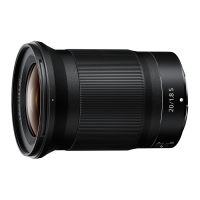
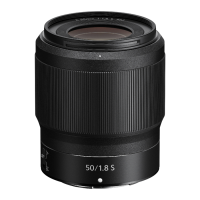
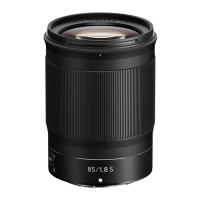
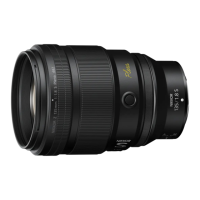
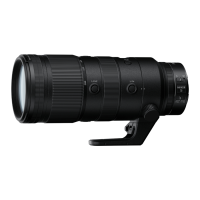
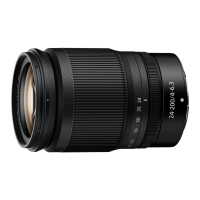
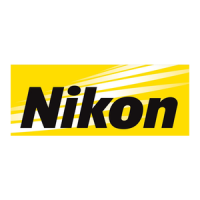
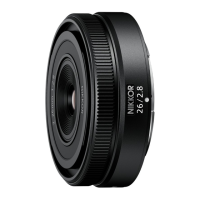
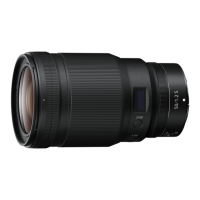
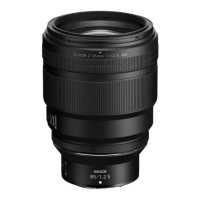
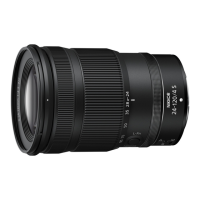
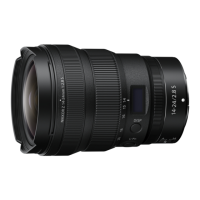
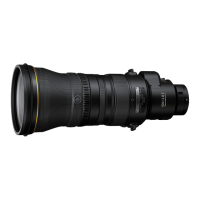
